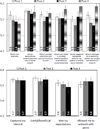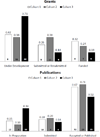Enhancing the Careers of Under-Represented Junior Faculty in Biomedical Research: The Summer Institute Program to Increase Diversity (SIPID)
- PMID: 25684827
- PMCID: PMC4324679
- DOI: 10.1016/s0027-9684(15)30070-5
Enhancing the Careers of Under-Represented Junior Faculty in Biomedical Research: The Summer Institute Program to Increase Diversity (SIPID)
Abstract
The Summer Institute Program to Increase Diversity (SIPID) in Health-Related Research is a career advancement opportunity sponsored by the National Heart, Lung, and Blood Institute. Three mentored programs address difficulties experienced by junior investigators in establishing independent research careers and academic advancement. Aims are to increase the number of faculty from under-represented minority groups who successfully compete for external research funding. Data were collected using a centralized data-entry system from three Summer Institutes. Outcomes include mentees' satisfaction rating about the program, grant and publications productivity and specific comments. Fifty-eight junior faculty mentees (38% male) noticeably improved their rates of preparing/submitting grant applications and publications, with a 18-23% increase in confidence levels in planning and conducting research. According to survey comments, the training received in grantsmanship skills and one-on-one mentoring were the most valuable program components. The SIPID mentoring program was highly valued by the junior faculty mentees. The program will continue in 2011-2014 as PRIDE (PRogram to Increase Diversity among individuals Engaged in health-related research). Long-term follow-up of current mentees will be indexed at five years post training (2013). In summary, these mentoring programs hope to continue increasing the diversity of the next generation of scientists in biomedical research.
Figures



References
-
- Rosamond W, Flegal K, Friday G, Furie K, Go A, Greenlund K, Naase N, Ho M, Howard V, Kissela B, Kittner S, Lloyd-Jones D, McDermott M, Meigs J, Moy C, Nichol G, O’Donnell CJ, Roger V, Rumsfeld J, Sorlie P, Steinberger J, Thom T, Wasserthiel-Smoller S, Hong Y for the American Heart Association Statistics Committee and Stroke Statistics Subcommittee. Heart disease and stroke statistics – 2007 update: A report from the American Heart Association statistics committee and stroke statistics subcommittee. Circulation. 2007;115:e69–e171. - PubMed
-
- Centers for Disease Control and Prevention. [Last accessed 5/18/2010];United States Life Table. 2000 (available at: http://www.cdc.gov/nchs/data/hus/hus08.pdf#026).
-
- Indian Health Service. [Last accessed 5/18/2010];Trends in Indian Health 2002–2003 Edition. U.S. Department of Health and Human Services, Indian Health Service, Office of Public Health Support, Division of Program Statistics. 2003 ( http://www.ihs.gov/NonMedicalPrograms/IHS_stats/index.cfm?module=hqPub).
Grants and funding
LinkOut - more resources
Full Text Sources

